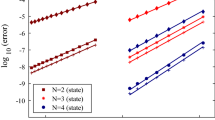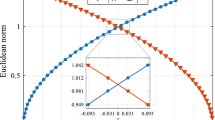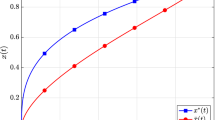Abstract
A local convergence rate is established for an orthogonal collocation method based on Gauss quadrature applied to an unconstrained optimal control problem. If the continuous problem has a smooth solution and the Hamiltonian satisfies a strong convexity condition, then the discrete problem possesses a local minimizer in a neighborhood of the continuous solution, and as the number of collocation points increases, the discrete solution converges to the continuous solution at the collocation points, exponentially fast in the sup-norm. Numerical examples illustrating the convergence theory are provided.



Similar content being viewed by others
References
Benson, D.A., Huntington, G.T., Thorvaldsen, T.P., Rao, A.V.: Direct trajectory optimization and costate estimation via an orthogonal collocation method. J. Guid. Control Dyn. 29(6), 1435–1440 (2006)
Garg, D., Patterson, M.A., Hager, W.W., Rao, A.V., Benson, D.A., Huntington, G.T.: A unified framework for the numerical solution of optimal control problems using pseudospectral methods. Automatica 46, 1843–1851 (2010)
Elnagar, G., Kazemi, M., Razzaghi, M.: The pseudospectral Legendre method for discretizing optimal control problems. IEEE Trans. Automat. Control 40(10), 1793–1796 (1995)
Fahroo, F., Ross, I.M.: Costate estimation by a Legendre pseudospectral method. J. Guid. Control Dyn. 24(2), 270–277 (2001)
Elnagar, G.N., Kazemi, M.A.: Pseudospectral Chebyshev optimal control of constrained nonlinear dynamical systems. Comput. Optim. Appl. 11(2), 195–217 (1998)
Fahroo, F., Ross, I.M.: Direct trajectory optimization by a Chebyshev pseudospectral method. J. Guid. Control Dyn. 25, 160–166 (2002)
Fahroo, F., Ross, I.M.: Pseudospectral methods for infinite-horizon nonlinear optimal control problems. J. Guid. Control Dyn. 31(4), 927–936 (2008)
Garg, D., Patterson, M.A., Darby, C.L., Françolin, C., Huntington, G.T., Hager, W.W., Rao, A.V.: Direct trajectory optimization and costate estimation of finite-horizon and infinite-horizon optimal control problems using a Radau pseudospectral method. Comput. Optim. Appl. 49(2), 335–358 (2011)
Liu, F., Hager, W.W., Rao, A.V.: Adaptive mesh refinement method for optimal control using nonsmoothness detection and mesh size reduction. J. Frankl. Inst. 352, 4081–4106 (2015)
Patterson, M.A., Hager, W.W., Rao, A.V.: A \(ph\) mesh refinement method for optimal control. Optim. Control Appl. Meth. 36, 398–421 (2015)
Williams, P.: Jacobi pseudospectral method for solving optimal control problems. J. Guid. Control Dyn. 27(2), 293–297 (2004)
Kang, W.: The rate of convergence for a pseudospectral optimal control method. In: Proceeding of the 47th IEEE Conference on Decision and Control, IEEE, pp. 521–527 (2008)
Kang, W.: Rate of convergence for the Legendre pseudospectral optimal control of feedback linearizable systems. J. Control Theory Appl. 8, 391–405 (2010)
Gong, Q., Ross, I.M., Kang, W., Fahroo, F.: Connections between the covector mapping theorem and convergence of pseudospectral methods for optimal control. Comput. Optim. Appl. 41(3), 307–335 (2008)
Dontchev, A.L., Hager, W.W.: Lipschitzian stability in nonlinear control and optimization. SIAM J. Control Optim. 31, 569–603 (1993)
Dontchev, A.L., Hager, W.W.: The Euler approximation in state constrained optimal control. Math. Comput. 70, 173–203 (2001)
Dontchev, A.L., Hager, W.W., Veliov, V.M.: Second-order Runge–Kutta approximations in constrained optimal control. SIAM J. Numer. Anal. 38, 202–226 (2000)
Dontchev, A.L., Hager, W.W., Malanowski, K.: Error bounds for Euler approximation of a state and control constrained optimal control problem. Numer. Funct. Anal. Optim. 21, 653–682 (2000)
Hager, W.W.: Runge-Kutta methods in optimal control and the transformed adjoint system. Numer. Math. 87, 247–282 (2000)
Kameswaran, S., Biegler, L.T.: Convergence rates for direct transcription of optimal control problems using collocation at Radau points. Comput. Optim. Appl. 41(1), 81–126 (2008)
Reddien, G.W.: Collocation at Gauss points as a discretization in optimal control. SIAM J. Control Optim. 17(2), 298–306 (1979)
Nocedal, J., Wright, S.J.: Numerical Optimization, 2nd edn. Springer, New York (2006)
Hager, W.W.: Numerical analysis in optimal control. In: Hoffmann, K.H., Lasiecka, I., Leugering, G., Sprekels, J., Tröltzsch, F. (eds.) International Series of Numerical Mathematics, vol. 139, pp. 83–93. Birkhauser Verlag, Basel (2001)
Hager, W.W., Hou, H., Rao, A.V.: Lebesgue constants arising in a class of collocation methods (2015). arXiv:1507.08316
Elschner, J.: The h-p-version of spline approximation methods for Mellin convolution equations. J. Integral Equ. Appl. 5(1), 47–73 (1993)
Horn, R.A., Johnson, C.R.: Matrix Analysis. Cambridge University Press, Cambridge (2013)
Acknowledgments
The authors gratefully acknowledge support by the Office of Naval Research under Grants N00014-11-1-0068 and N00014-15-1-2048 and by the National Science Foundation under Grants DMS-1522629 and CBET-1404767. Comments and suggestions from the reviewers are gratefully acknowledged. In particular, in the initial draft of this paper, it was assumed that \(\nabla ^2 C(\mathbf{{x}}^*(1))\) was positive definite, while one of the reviewers correctly pointed out that this assumption could be relaxed to positive semidefinite without effecting the convergence results for a stationary point of the discrete problem.
Author information
Authors and Affiliations
Corresponding author
Appendix
Appendix
In (15), we define a new matrix \(\mathbf{{D}}^\dagger \) in terms of the differentiation matrix \(\mathbf{{D}}\). The following proposition shows that the elements of \(\mathbf{{D}}^\dagger \) can be gotten by rearranging the elements of \(\mathbf{{D}}\).
Proposition 10.1
The entries of the matrices \(\mathbf{{D}}\) and \(\mathbf{{D}}^\dagger \) satisfy
In other words, \(\mathbf{{D}}_{1:N} = -\mathbf{{J}} \mathbf{{D}}_{1:N}^\dagger \mathbf{{J}}\) where \(\mathbf{{J}}\) is the exchange matrix with ones on its counterdiagonal and zeros elsewhere. Equivalently, \(\mathbf{{D}}_{1:N}^\dagger = -\mathbf{{J}} \mathbf{{D}}_{1:N} \mathbf{{J}}\).
Proof
By (9) the elements of \(\mathbf{{D}}\) can be expressed in terms of the derivatives of a set of Lagrange basis functions evaluated at the collocation points:
In (9) we give an explicit formula for the Lagrange basis functions, while here we express the basis function in terms of polynomials \(L_j\) that equal one at \(\tau _j\) and vanish at \(\tau _k\) where \(0 \le k \le N\), \(k \ne j\). These \(N +1\) conditions uniquely define \(L_j \in \mathcal{{P}}_N\). Similarly, by Garg et al. [2, Thm. 1], the entries of \(\mathbf{{D}}_{1:N}^\dagger \) are given by
Observe that \(M_{N+1-j}(t) = L_j (-t)\) due to the symmetry of the quadrature points around \(t = 0\):
-
(a)
Since \(-\tau _{N+1-j} = \tau _j\), we have \(L_j (-\tau _{N+1-j}) = L_j (\tau _j) = 1\).
-
(b)
Since \(\tau _{N+1} = 1\) and \(\tau _0 = -1\), we have \(L_j (-\tau _{N+1}) = L_j (\tau _0) = 0\).
-
(c)
Since \(-\tau _i = \tau _{N+1-i}\), we have \(L_j (-\tau _{i}) = L_j (\tau _{N+1-i}) = 0\) if \(i \ne N+1-j\).
Since \(M_{N+1-j}(t)\) is equal to \(L_j (-t)\) at \(N+1\) distinct points, the two polynomials are equal everywhere. Replacing \(M_{N+1-j}(t)\) by \(L_j (-t)\), we have
\(\square \)
Tables 1 and 2 illustrate properties (P1) and (P2) for the differentiation matrix \(\mathbf{{D}}\). In Table 1, we observe that \(\Vert \mathbf{{D}}_{1:N}^{-1}\Vert _\infty \) monotonically approaches the upper limit 2. More precisely, it is found that \(\Vert \mathbf{{D}}_{1:N}^{-1}\Vert _\infty = 1 + \tau _N\), where the final collocation point \(\tau _N\) approaches one as N tends to infinity. In Table 2, we give the maximum 2-norm of the rows of \([\mathbf{{W}}^{1/2} \mathbf{{D}}_{1:N}]^{-1}\). It is found that the maximum is attained by the last row of \([\mathbf{{W}}^{1/2} \mathbf{{D}}_{1:N}]^{-1}\), and the maximum monotonically approaches \(\sqrt{2}\).
Rights and permissions
About this article
Cite this article
Hager, W.W., Hou, H. & Rao, A.V. Convergence Rate for a Gauss Collocation Method Applied to Unconstrained Optimal Control. J Optim Theory Appl 169, 801–824 (2016). https://doi.org/10.1007/s10957-016-0929-7
Received:
Accepted:
Published:
Issue Date:
DOI: https://doi.org/10.1007/s10957-016-0929-7




